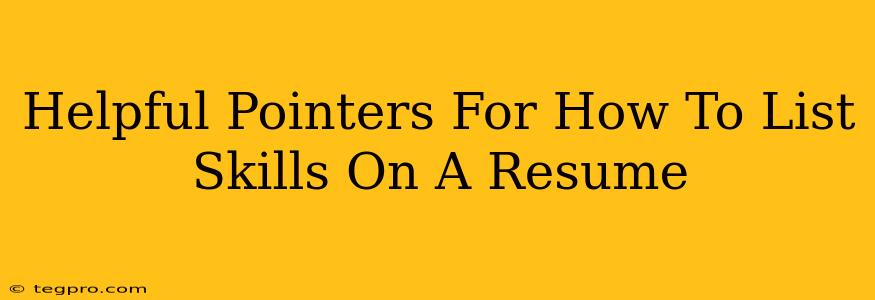Landing that dream job often hinges on how effectively you present yourself. Your resume is your first impression, and showcasing your skills strategically is crucial. This guide provides helpful pointers on how to list skills on a resume, ensuring it grabs recruiters' attention and lands you that interview.
Understanding the Importance of Skill Sections
Before diving into how to list skills, let's understand why it's so important. A well-crafted skills section acts as a quick summary of your capabilities. Recruiters often scan resumes for keywords related to the job description, and a strong skills section makes it easy for them to quickly identify if you're a good fit. Think of it as a highly targeted, visually appealing advertisement of you.
Keywords are Key
Keyword optimization is vital. Research the job descriptions you're targeting and incorporate relevant keywords into your skills section. Don't just list skills; tailor them to the specific roles you're applying for. This helps Applicant Tracking Systems (ATS) – the software companies use to filter resumes – pick up your application.
Crafting the Perfect Skills Section: Methods and Examples
There are several effective ways to list skills on your resume. The best method will depend on your experience level and the type of job you're seeking.
Method 1: Categorized Skills
This approach groups skills into logical categories, making it easy to scan. For example:
Technical Skills: Proficient in Microsoft Office Suite (Word, Excel, PowerPoint), Adobe Creative Suite (Photoshop, Illustrator), SQL, Python, Java.
Communication Skills: Excellent written and verbal communication, public speaking, presentation skills, active listening.
Leadership Skills: Team management, project management, conflict resolution, mentorship.
Method 2: Skills Matrix
A skills matrix presents skills visually, often using a rating system (e.g., beginner, intermediate, expert). This is especially helpful for demonstrating proficiency levels across various skills.
| Skill | Proficiency Level |
|---|---|
| Project Management | Expert |
| Data Analysis | Intermediate |
| Customer Service | Expert |
| Social Media Marketing | Beginner |
Method 3: Skills Integrated into Work Experience
Instead of a separate skills section, you could integrate skills directly into your work experience descriptions. This method showcases how you've applied your skills in practical situations, making your resume more compelling.
For example, instead of simply stating "Proficient in Excel," you could write: "Utilized advanced Excel functions (pivot tables, macros) to analyze sales data, resulting in a 15% increase in efficiency."
Tips for Maximizing Impact
- Quantify your accomplishments: Don't just list skills; showcase how you've used them to achieve measurable results. Use numbers and data to demonstrate your impact.
- Tailor to each job: Customize your skills section for each job application. Highlight the skills most relevant to the specific job description.
- Use action verbs: Start each skill with a strong action verb (e.g., managed, developed, implemented, analyzed).
- Keep it concise: Avoid overly long lists. Focus on your most relevant and valuable skills.
- Proofread carefully: Errors can undermine your credibility. Thoroughly proofread your resume before submitting it.
Beyond the List: Showing, Not Just Telling
Remember, your resume is a marketing document. The goal is not just to list skills but to convincingly demonstrate your capabilities. Use the STAR method (Situation, Task, Action, Result) in your work experience descriptions to illustrate how you've used your skills to solve problems and achieve success. By combining a well-structured skills section with compelling work experience narratives, you'll significantly increase your chances of landing an interview.

